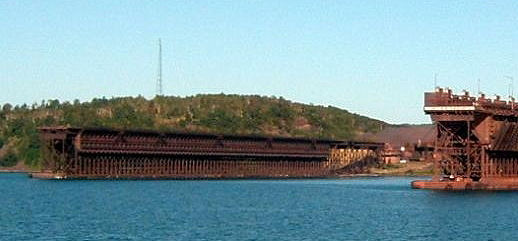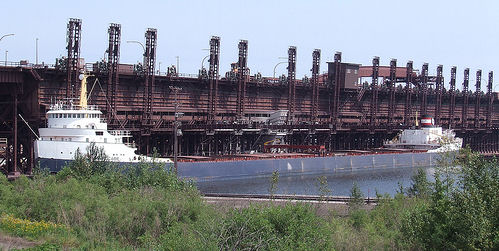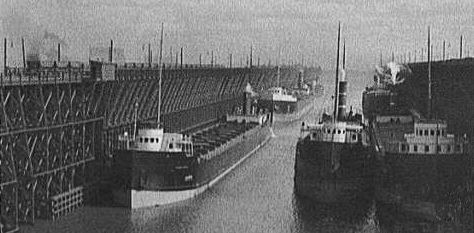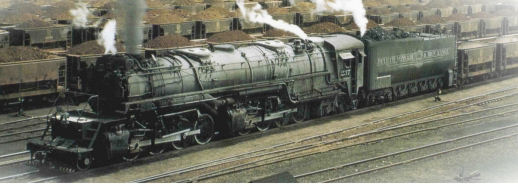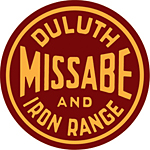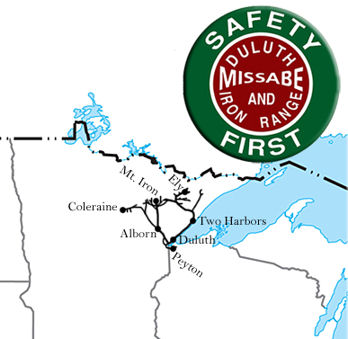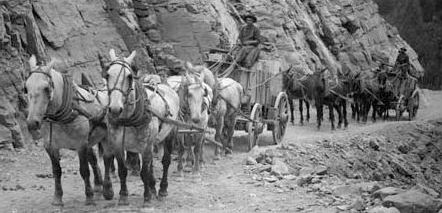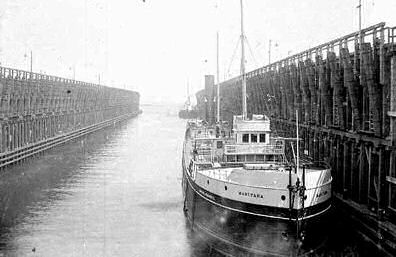
IRON ORE SHIPPING
Duluth and Iron Range Railway Ore Dock No. 6 at Two Harbors, Minnesota
Dock No. 6 was constructed from 1907-1909 and was the first steel ore dock built on the Great Lakes. The dock was designed by the American Bridge Company and constructed by the Barnett & Record Company. The dock was a vital link for the rich iron mines in northern Minnesota. The dock is located at the terminus of the Duluth & Iron Range Railway line (later Duluth, Missabe, and Iron Range Railway).
The dock is 962' long, 51' wide and 74' high. The dock has 148 pockets with ship loading spouts along each side. Ore loaded into vessels through mechanically operated trapdoors at the bottom of the pockets flowing by gravity through the openings. The pockets were filled by railroad hopper ore cars from the four tracks on the dock. These four tracks were connected with two tracks on the approach trestles connected to the railroad yard. The capacity of each pocket is 300 tons thus yielding a total storage capacity of 44,440 tons.
The dock is no longer in use and has been placed on the National Register of Historic Places. The connecting trestles were removed in 1978. The two nearby docks are operational though only dock number two is used because it has been modified to accommodate Taconite pellets.
Duluth Ore Docks
These two docks are the largest and second largest structures of their type, both being about 2,300 feet long and 80 feet high above the water. The ore docks have four tracks on them. Two tracks fill pockets on one side of the dock, two on the other. There is a double crossover at the head of the dock to allow dock and Hill engines to tie onto different cuts of cars.
Each ore dock has pockets that are 12-feet on center and each pocket can hold four carloads of ore. Ore grades can be mixed as they are dumped into the pockets to meet Boat requirements, but to achieve the best flow out of the pocket, the first load of ore should be a coarse ore dumped from the inner track.
If needed, a string of cars can be held on top of the dock to be dumped when the Boat arrives, effectively allowing five carloads per pocket.
The cars and the Boat hatches are on 24-foot centers. Thus, every other pocket will be discharged into a Boat, the Boat winched ahead or back, and the intermediate pockets discharged.
Duluth ore docks about 1910 when they were still wooden structures.
Iron ore, once mined, had to be shipped to a smelter for processing. Originally ore was hauled by horse-drawn wagon to a shipping point on Lake Superior. This inefficient method was replaced by rail tram cars, which were then soon replaced by steam powered railroads. Once at the shipping point the ore was first loaded on sailing schooners, later, steam powered vessels, and still later ore boats designed to haul bulk ore cargoes exclusively.
The DM&IR was formed by the 1937 merger of the Duluth, Missabe and Northern Railway (DM&N) and the Spirit Lake Transfer Railway; the Duluth and Iron Range Rail Road (D&IR) and Interstate Transfer Railway were added in 1938. All of these had been leased by the DM&N since 1930.
The DM&N was incorporated in 1891 and the first load of iron ore was shipped to Superior, Wisconsin in October, 1892. (The formation of the railway was necessary after the discovery of high-grade Mesabi iron ore near Mountain Iron, Minnesota by the Seven Iron Men. The D&IR was approached to construct a new branch line, but was not receptive.) The Merritt's expanded DM&N by laying track to Duluth, Minnesota in 1893 and built an ore dock there. The Merritt's shaky financial position, brought in part to building the Duluth expansion, allowed for John D. Rockefeller to gain control of the railway in 1894. In 1901, Rockefeller sold the DM&N to U.S. Steel. From 1901 to 1938 the two railways were owned and operated by U.S. Steel and were operated independently.
By July 1938 the two railways merged to form the DM&IR. The railway had two operating divisions, the Missabe and the Iron Range based upon their predecessor's roads. As the United States began to prepare for the Second World War, the iron ore tonnage moving over the Missabe Road more than doubled from little over 8 million tons in 1938 to over 18 million tons in 1939 and lept to almost 28 million tons in 1940 and over 37 million tons in 1941.
With such high tonnage levels, it was obvious that DM&IR needed additional locomotive power to handle the higher traffic volume. The first eight of DM&IR's famous 2-8-8-4 Yellowstone locomotives (listed as Class M on their roster) were delivered by Baldwin Locomotive Works in the Spring of 1941. Along with the Yellowstones the DM&IR also operated heavy 2-8-8-2 articulateds (also listed as Class M) , 2-8-2 Mikados, 2-10-2 Santa Fes, and 2-10-4 Texas Types.[citation needed] Total ore movement of nearly 45 million tons in 1942 stressed the critical need for more locomotive power on the DM&IR and the War Production Board allowed the Missabe to order ten more Yellowstones. The new locomotives were delivered in 1943.
After WWII, the DM&IR continued to haul increasingly larger tonnage of ore to the ore docks along Lake Superior reaching an all-time record year of over 49 million tons in 1953. Also in 1953, the first diesel locomotives, EMD SW9s, arrived on the railway. The Missabe continued to dieselize with the 1956 delivery of EMD SD9s. The last revenue steam run occurred in 1960. Passenger services on the Missabe Division ended in 1957 and completely ceased in 1961.
DM&IR Route Map
The D&IR was formed in 1874 by Charlemagne Tower to haul iron ore from the Minnesota Iron Co. in Tower, Minnesota to the new Lake Superior port of Two Harbors, Minnesota. The first ore shipment from the Soudan Mine over the D&IR was on July 31, 1884. The D&IR was acquired by Illinois Steel in 1887. In 1901, Illinois Steel became part of the newly formed United States Steel Corporation (USS) and the railway became part of its holdings.
The DM&N was incorporated in 1891 and the first load of iron ore was shipped to Superior, Wisconsin in October, 1892. (The formation of the railway was necessary after the discovery of high-grade Mesabi iron ore near Mountain Iron, Minnesota by the Seven Iron Men. The D&IR was approached to construct a new branch line, but was not receptive.) The Merritt's expanded DM&N by laying track to Duluth, Minnesota in 1893 and built an ore dock there. The Merritt's shaky financial position, brought in part to building the Duluth expansion, allowed for John D. Rockefeller to gain control of the railway in 1894. In 1901, Rockefeller sold the DM&N to U.S. Steel. From 1901 to 1938 the two railways were owned and operated by U.S. Steel and were operated independently.
In addition to dieselization and the end of passenger service, other changes were happening to the DM&IR. The availability of high-quality iron ore was becoming limited. Mines and pits were closing across Minnesota's iron ranges. The DM&IR's ore docks in Two Harbors were closed in 1963 and didn't reopen until 1966. The Missabe Road was saved by the November 3, 1963 passage of the Taconite Amendment to the Minnesota State Constitution. (The amendment restricted the state's ability to tax a taconite industry for twenty-five years.) The passage of the amendment accelerated the creation of taconite mining industry in Northern Minnesota. The Eveleth Taconite Company was formed in 1964 and on April 8, 1966, the SS Edmund Fitzgerald took on the first load of Eveleth taconite pellets, totally about 23,000 tons. The taconite era on the Missabe had begun.
In 1988, U.S. Steel, now USX, spun off the DM&IR and their other ore railroads and shipping companies into subsidiary Transtar, then sold majority control to the Blackstone Group and USX. In 2001, the DM&IR, and other holdings, were spun off from Transtar into the company Great Lakes Transportation (GLT) which was owned fully by the Blackstone Group. (For the first time in over 100 years DM&IR was no longer associated with U.S. Steel.) In late 2003, the Blackstone Group agreed to sell GLT to Canadian National Railway and the purchase was finalized on May 10, 2004.
Steamer Maritana at Duluth & Iron Range RR docks, Two Harbors
